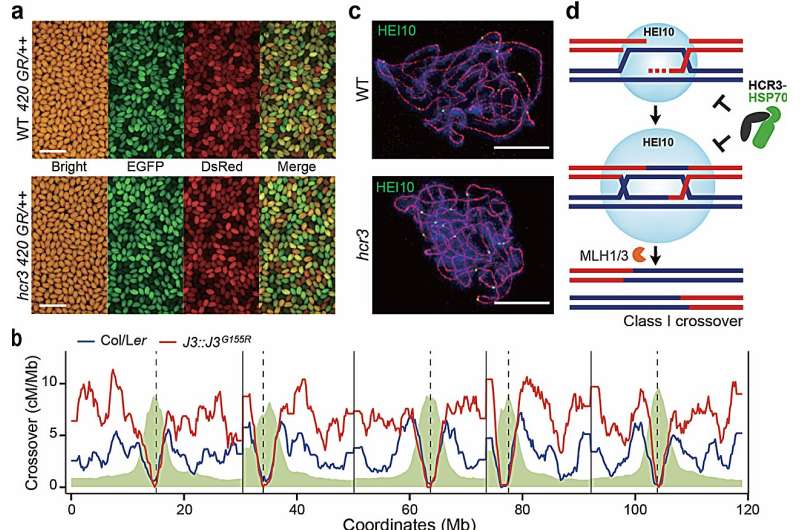This article has been reviewed according to Science X's editorial process and policies. Editors have highlighted the following attributes while ensuring the content's credibility:
fact-checked
peer-reviewed publication
trusted source
proofread
Mutation solves a century-old mystery in meiosis

A high-throughput genetic screening of meiotic crossover rate mutants in Arabidopsis thaliana has unraveled a century-old mystery in the life sciences.
A research team, consisting of Professor Kyuha Choi, Dr. Jaeil Kim, and Ph.D. candidate Heejin Kim from the Department of Life Sciences at Pohang University of Science and Technology (POSTECH), has unveiled the molecular mechanism responsible for crossover interference during meiosis, a biological pattern at the chromosome level.
The findings of this research were published on February 20 in Nature Plants.
In sexually reproducing organisms, individuals resemble their parents or siblings. Despite the striking similarities, it's crucial to recognize that absolute identicalness is unattainable. This variation is attributed to the process of meiosis, which generates reproductive cells like sperm and eggs in animals or pollen and ovules in plants. Unlike somatic cell division, which duplicates and divides the genome identically, meiosis creates genetically diverse reproductive cells through a mechanism known as crossover.
Meiosis and crossover play pivotal roles in biodiversity and have significant implications in breeding where the selection and cultivation of superior traits in crops occur.
Typically, most animal and plant species exhibit a minimum of one and a maximum of three crossovers per a pair of homologous chromosomes. The ability to control the number of these crossovers could lead to cultivating crops with specific desired traits. However, achieving such control has been challenging due to the "phenomenon of crossover interference."
Crossover interference, where one crossover inhibits the formation of another crossover nearby along the same chromosome, was initially identified by fruit fly geneticist Hermann J. Muller in 1916. Despite researchers' persistent efforts over the past century since its discovery, it is only recently that the mechanisms underlying crossover interference have started to unveil their secrets.
In this research, the team utilized a high-throughput fluorescent seed scoring method to directly measure crossover frequency in Arabidopsis plants. Through a genetic screen, they identified a mutant named hcr3 (high crossover rate3) that exhibited an increased crossover rate at the genomic level.
Further analysis revealed that the elevated crossovers in hcr3 was attributed to a point mutation in the J3 gene, which encodes a co-chaperone related to HSP40 protein. This research demonstrated that a network involving HCR3/J3/HSP40 co-chaperone and the chaperone HSP70 controls crossover interference and localization by facilitating the degradation of the pro-crossover protein, HEI10 ubiquitin E3 ligase.
The application of genetic screen approaches to uncover the crossover interference and inhibition pathway successfully addressed a century-old puzzle in the life sciences.
POSTECH Professor Kyuha Choi stated, "Applying this research to agriculture will enable us to rapidly accumulate beneficial traits, thereby reducing breeding time. We hope this research will contribute to the breeding of new varieties and identification of useful natural variations responsible for desirable traits such as disease and environmental stress resistance, improved productivity, and high-value production."
More information: Heejin Kim et al, Control of meiotic crossover interference by a proteolytic chaperone network, Nature Plants (2024). DOI: 10.1038/s41477-024-01633-y
Journal information: Nature Plants
Provided by Pohang University of Science and Technology




















